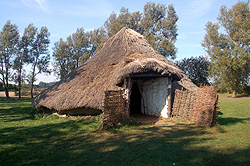The Bedfordshire Historic Environment Record [HER] contains information on the county's historic buildings and landscapes and summaries of each entry can now be found online as part of the Heritage Gateway website.
Unlike neighbouring Husborne Crawley, for example, there is quite abundant evidence for human activity in Ridgmont in prehistory. The earliest example was the find of a Mesolithic axe and a number of flint flakes at a site on the greensand ridge. The waste flakes were of good quality flint. The hand axe may indicate clearance activity or specialised woodland exploitation. Some of the flakes had been retouched and appear to have been used as cutting tools [HER 15834].
Field-walking around the A507 road and farm tracks to the north of Ridgmont and within the M1 widening corridor recovered Mesolithic flint included within an assemblage including late Neolithic and Bronze Age material. The Mesolithic flints included waste flakes and cores and may indicate a temporary settlement [HER 15833]. Field-walking in the area of Beckerings Park recovered a number of flint cores and flakes, all of Neolithic to Bronze Age date [HER 16086]. More prehistoric flints were recovered north-west of Partridge Ramese. There were five flints in total, two were retouched and may have been used as scrapers. The other three were flakes of which two were broken [HER 13484].

A reconstruction of an Iron Age round house at Flag Fen October 2011
There is a variety of evidence for Iron Age occupation on a site along the line of the A507 Ridgmont Bypass. The excavations were carried out via trial trenching and test pits. The test pits produced a number of pottery sherds. Six were datable to the early or middle Iron Age and only one sherd of late Iron Age pot was recovered. Trial trenching produced ditches, a pit and a posthole as well as a possible enclosure. These features suggest a settlement, which is supported by the amount of pottery recovered from the features [HER 13425].
Located on a false crest twenty five metres north of the M1 motorway and south-east of the Fruit Farm is a north-east to south-west orientated curvilinear ditch. It has been dated to the Iron Age but this is debatable due to the present of only one abraded pot sherd for dating evidence. Prior to excavation, geophysical survey had suggested that this was the remains of a possible burial mound, but this was not confirmed [HER 13424]. Cropmarks next to the M1, south of Beckerings Park indicate traces of two large rectangular enclosures which might be Iron Age [HER 9073].
The Viatores are a group dedicated to finding Roman roads in the modern landscape. They have identified a road running from Dorchester-on-Thames [Oxfordshire] to Alconbury House [Huntingdonshire] which ran through Bedfordshire [HER 485]. The road runs through Astwick, Edworth, Dunton, Biggleswade, Langford, Henlow, Clifton, Shefford, Campton, Clophill, Maulden, Flitwick, Steppingley, Eversholt, Ridgmont, Husborne Crawley and Aspley Guise. The road can be seen as an agger – a raised linear feature which tapers from the central line down each side, representing the carriageway of the road. The surviving section lies east of Redfield Farm [HER 10454]
Cropmarks showing a rectangular enclosure to the north-east of Segenhoe Manor [HER 552] may be Romano-British. A Roman quern, or grinding stone, was found at Segenhoe and donated to LutonMuseum at an unspecified date [HER 1972]. It was made of Hertfordshire conglomerate known as puddingstone. Finally, a late Iron Age or Roman brooch was discovered at Segenhoe [HER 16002]. Made from bronze it is in the shape of a dolphin. Both the bow and the semi-cylindrical wings are plain and the spring would have been secured through a double pierced head plate.